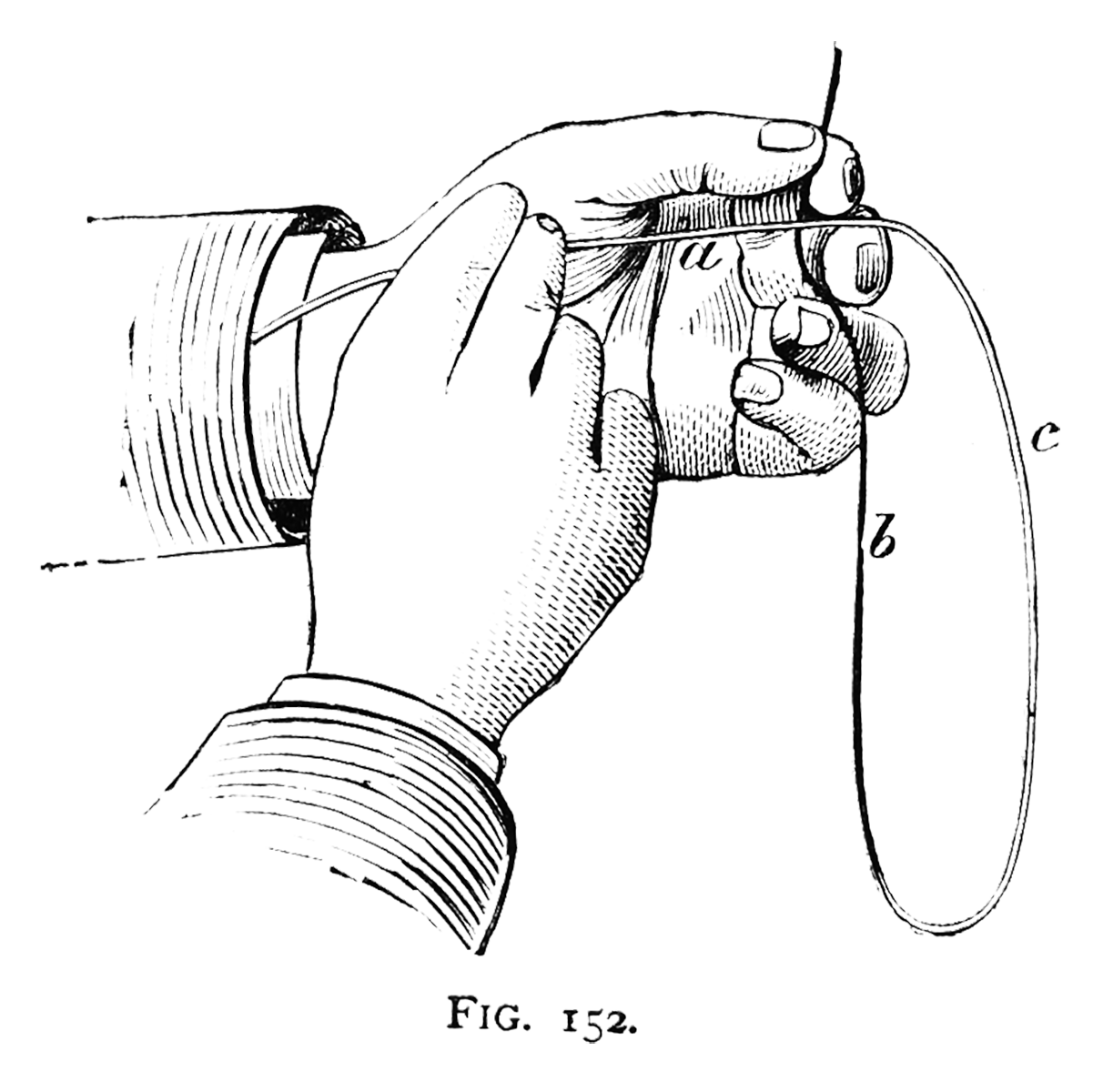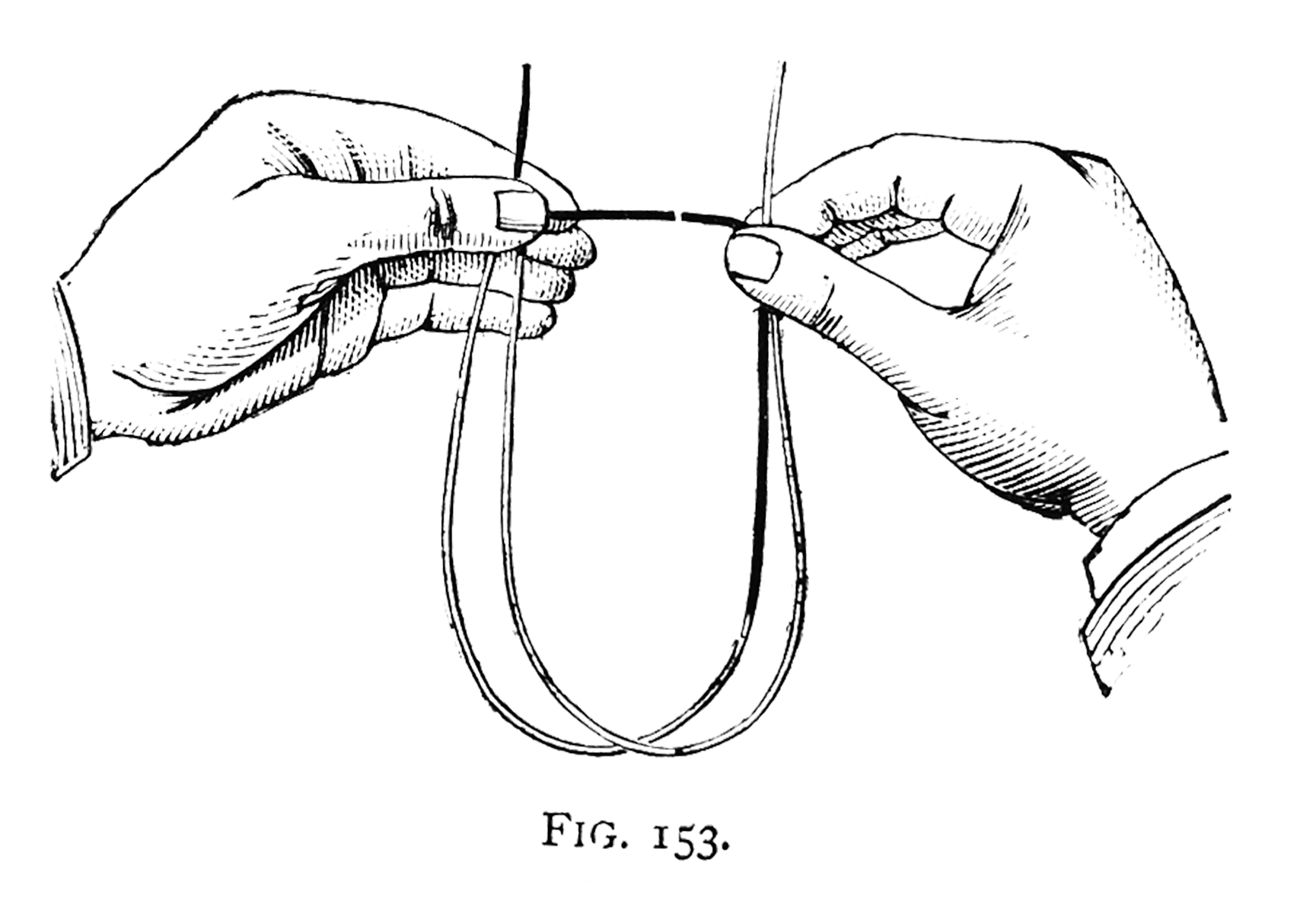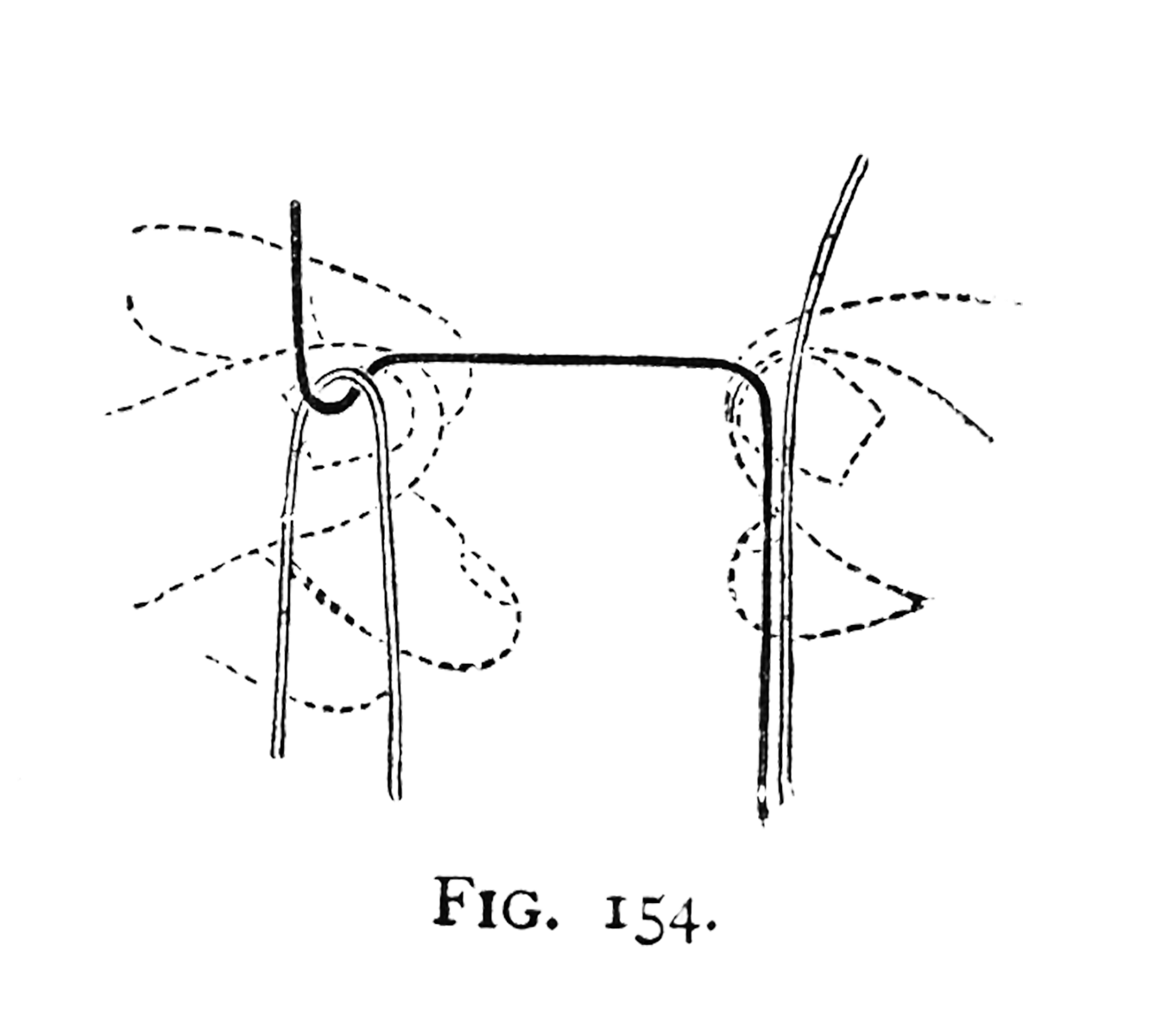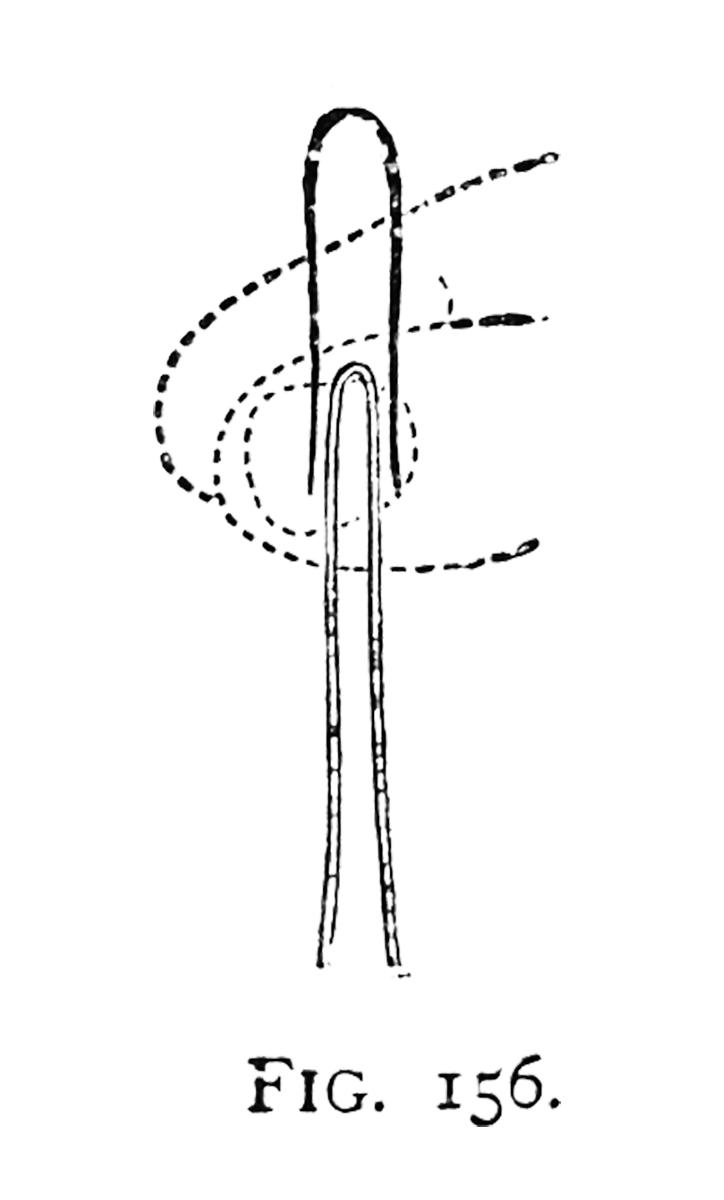issue 04: craft
of the bird’s death, and resurrection
thomas huston




“The Cut String Restored," Figs. 152–156, from Professor Hoffman, Modern magic: a practical treatise on the art of conjuring (London: George Routledge and Sons, Limited, 1894), 318–319.
"That every intervention, whatever its purpose, implies a modification, derives from the fact that on a technical and aesthetic as well as physical level, there is no conservation without transformation; what varies, and certainly matters, is the kind, extent and duration of this transformation."
—Dario Gamboni1
"I don’t believe in preserving. I think, as I said, that a work of art dies."
—Marcel Duchamp2
An overgrown garden in late summer. The garden is roughly square-shaped, with entrances on two opposing sides, and a path that is overgrown and barely legible. In the centre of this garden, surrounded by the path: tall grass and goldenrod with a smattering of wildflowers.
Rising up in this tiny prairie is an unassuming object sitting on a small plywood base mounted to the top of a wrought iron rod. This object has no discernable shape, and when viewed up close appears to be made of birdseed mixed into chocolate.
Two house sparrows and a black-capped chickadee peck at the object, and it becomes sustenance. Over the next few months, the chocolate and birdseed are slowly consumed until nothing remains but the plywood base, covered in bird droppings.
One of the earliest accounts of magic, from the fourth story of the ancient Egyptian Westcar Papyrus, tells of a magician called Djedi.3 The Pharaoh Khufu summoned Djedi to his palace after hearing of the 110-year-old man who could resurrect decapitated beings and tame wild animals. When the magician arrived at the palace, the Pharaoh asked to have a prisoner brought up to be executed so that Djedi could demonstrate his skill.
In order to spare human suffering, Djedi instead gathered a goose, a water bird, and a bull. In turn, each was decapitated. Their heads were then placed on one end of the hall and their bodies on the other. Upon the utterance of some carefully chosen words, the heads and bodies travelled to the middle of the hall and were reunited. Each animal subsequently returned to life as if nothing had happened at all.
But even the greatest magician cannot reverse the sleep of death or stop the hands of time. According to the “Modern analysis” section of Djedi’s Wikipedia entry, “magical tricks that show animals being decapitated and their heads being replaced were performed as recently as a few decades ago, though today they are rarely shown because of aesthetical and ethical misgivings.”4
Upon reading this, I began a frenzied search for methods by which an animal might appear to be decapitated and then restored to life. In the course of this search, I came across a discussion from 2006 on The Magic Cafe—an online forum for magicians—that debates the ethics (more optics than ethics, really) of “pulling the head off of a dove.”5 I also found a 1988 routine by David Copperfield in which the head of a rooster is swapped with the head of a duck to the soundtrack of Sam Cooke’s “What a Wonderful World.” But to find a method for any such trick, I had to look further back.
In his memoir, the magician Jean-Eugène Robert-Houdin recounts the origin of his career. As he tells it, he accidentally received a book of “scientific amusements” in place of the watchmaking text he had intended to purchase. Nestled among the wonders within? “To cut off a pigeon’s head, to restore it to life.”6 Try as I might, the closest I could come to finding the source of this method was “Of the Bird’s Death, and Resurrection,” in Natural Magic: or, Physical Amusements Revealed, from 1785.
The Egg chosen out of the three, to dance on the Cane, being broken, but presently changed by the Conjurer to the real Egg, to show that it had not been previously prepared, the two others left upon the Table, are taken up; one of which is chosen by a Spectator, and, in breaking out flies a living Canary Bird. A Lady of the Company is desired to take the Bird into her Hand, and soon after it is found to be dead. Then it is taken from her, and laid under a Glass upon a Table; some Minutes after the Glass is taken off, and the Bird flies away.
Explanation: Two Eggs are emptied, and the half of the Shells are taken and adjusted together with two little Strips of Paper, glued in the Form of a Zone, or an Equator. Being thus prepared, they represent an Egg, and can contain a little living Canary Bird, provided that a little Hole be made in it with a Pin, to permit its free Respiration.
The Instant this Bird is delivered into the Hands of a Person who condescends to hold it, the Conjurer stifles it by a hard Squeeze between his Finger and Thumb. It is then put under a Glass, upon the Trap before-mentioned, in the first Experiment, such that the Compeer may place a living one in its Stead.7
Museums, like magicians, focus our attention on objects in the world in ways that relate to our lived experience but also often defy our expectations. They perform a sleight of hand in which they transform things—understood as accumulations of materials and physical processes that unfold over time, to borrow from Fernando Domínguez Rubio’s application of thing theory to museum work8—into objects.
Central to the work within the museum is the maintenance of not only an object, but an idea: the specific object’s fixed position within a set of aesthetic, political, and social practices and values.9 Whereas the magician who restores a dead bird to life is more concerned about the appearance of the continuity of the thing, the museum must ensure the actual material and conceptual continuity of the objects with which they are entrusted.
To do this, the museum relies heavily on the largely invisible labour of art workers, including, among others, building engineers, custodians, security guards, preparators, and conservators. My attention here is specifically on the labour of conservators towards the objects maintained within the museum.
Conserving an art object is often more complicated than merely returning it to an “original” state. Some objects may have been altered by their author over the course of their life, creating multiple “true” original states. In other cases, objects are intentionally made in such a way that they deteriorate over time, and eventually cease to exist legibly as an object at all. Paradoxically, in that case, truly conserving such an artwork means allowing it to die.
In his essay “The Lamp of Memory,” the 19th-century critic John Ruskin famously disavowed restoration, claiming that it “means the most total destruction which a building can suffer: a destruction out of which no remnants can be gathered: a destruction accompanied with false description of the thing destroyed.”10
The truth of a building, to Ruskin, could never be restored without reflecting the time in which the restoration occurred, creating a fictional palimpsest of a building. Veering towards the Romantic, Ruskin wrote that “it is impossible, as impossible as to raise the dead, to restore anything that has ever been great or beautiful in architecture.”11
The restoration that Ruskin so adamantly argued against is epitomised by the writing of his contemporary, Eugéne Viollet-le-Duc. Viollet-le-Duc saw restoration as a “means to reestablish [a building] to a finished state, which may in fact never have actually existed at any given time."12 In this sense, restoration denies the full history of an object, what Ruskin calls its Age and what German-Jewish philosopher Walter Benjamin might call its aura.13
Avoiding the romanticism of a singular, authentic object (the “here and now of the work of art”), I would argue instead for understanding the “authenticity” of an object as allowing a multitude of truths. These truths embrace the complex history of objects, not just in their material make-up but also their often contentious existence in various object positions through time, each with different aesthetic, political, and social uses and values.
The museum’s maintenance of an art object avoids restoration as articulated by Voillet-le-Duc, but it also does not allow for the truly prismatic meaning that all things contain. Instead, it attempts to suspend an object in time, fixing it to a singular position, often emphasising one specific history over any others. When objects do, inevitably, begin to show their age—cracks in the oil paint, an accumulation of dust on the surface, yellowing plastic, the fading memory of a body’s movement—the institution must intervene to mitigate this inevitable loss.
In sleight-of-hand magic, restoration is generally defined as the process by which “an object is damaged [and] then restored to its original condition.”14 This could take the form of a cut-and-restored rope, or a torn-and-restored newspaper. A more dramatic example might be a stage magician sawing a person in half, or decapitating a pigeon and then reuniting its head to its body and allowing it to fly away. Restoration is most often achieved through one of three general methods: the object was not actually damaged (a rubber band, for instance), the object was not actually restored (as in “restoring” a broken match), or a duplicate object was used (the torn-and-restored newspaper).15
What happens to an art object when it is damaged, broken beyond repair? Conservators, like magicians, sometimes utilise duplicate objects as a means of preservation. They might re-fabricate artworks where the intention of the artist allows, or use sanctioned exhibition copies that must be destroyed after they have served their purpose. Different materials demand different approaches; a photograph might have a different threshold for damage than a painting or a ceramic, and is easier to replace with an exhibition copy. Artists are often involved in these decisions, interviewed by conservators about how an artwork should look, whether material continuity is important over time, and if the object’s eventual deterioration should be mitigated or allowed to progress.16
Like a broken rubber band transformed through apparent restoration, an artwork can easily slip from one object position into another. In his book The Destruction of Art, Dario Gamboni relates a story about Joseph Beuys’ 1960 sculpture Badewanne, which consists of a bathtub Beuys had been bathed in as a child, “prepared” with fat-saturated bandages and gauze. The sculpture was being stored ahead of an exhibition, and the building where it was housed was rented out for a large party. In search of extra seating, the party guests accidentally gained access to the storeroom. Seeing the sculpture and apparently mistaking it for a functional object, they cleared it of its fat-laden accoutrements, filled it with ice, and used it to chill their beers.17
I often find myself telling and retelling a story about an exhibition I saw years ago. It was an exhibition of multiples and editions by the Swiss artist Dieter Roth, ironically titled Wait, Later This Will Be Nothing. Next to a small, wall-mounted vitrine was a label explaining that the adjacent artwork is intended “to be mounted on a post in the open air and consumed by birds until nothing remains.” Inside of the vitrine there was a small bust made of chocolate and birdseed.18 Its edges were slightly dulled and softened by time, but otherwise it was well preserved. Seeing it there—encased, entombed—I wanted to cry.
By preserving this object—holding it as more sacred than the idea it contains—the museum effectively killed it. To fetishise the object over the idea and preserve it materially instead of letting it disappear was a failure of the museum. Even the greatest magician cannot reverse the sleep of death or stop the hands of time.
When a conjurer “decapitates” a dove or a goose, the audience is suspended momentarily in a state of disbelief. To truly believe the animal decapitated would mean to accept an atrocity in front of one’s eyes. So we await the miracle with a sense of expectation for a restoration to wholeness. In this way, the magician could be understood as performing an act of what Domínguez Rubio calls mimeographic labour: the labour devoted to creating sameness.19 But sameness is not necessarily pure restoration. An essential feature of this labour is its invisibility. We do not see the mimeographic labour of the magician, because to see that work would undermine the wonder and disbelief that is produced by its apparent sameness.
The same can be said of the mimeographic labour within the museum—the labour performed by the conservator within a larger network of art workers. The hand of the conversator can never be legible to the audience, because it would undo the authoritative position of the singular Art Object (created by a singular Artist), which the museum seeks to maintain. While the conservator’s hand in the work must remain invisible, it is also necessary for the Art Object to retain the traces of its history.
In the world of conservation, over-cleaning an object tends to be a more serious issue than under-cleaning.20 If all indications of time’s passage are erased from an art object, it ceases to be legible as “real” or “authentic”—something with a history, however vague. This is the death that Ruskin warned against—the return of an object to a false truth, a pure state that never actually existed. This is the delicate balance of the museum.
Artworks like Roth’s birdseed bust, Félix González-Torres’s candy piles and stacks of posters, or a performance like Simone Forti’s Huddle are slipperier than most paintings or sculptures.21 They resist the rigid understanding of truth within the museum by refusing to be fixed in a singular object position. Whereas a sculpture in the museum’s care might pose the question of material continuity, these artworks perform a kind of disappearing act, begging the question of where and how the work actually exists.
I am reminded of a story about a man who, after spending a decade learning to paint, travelled the world making watercolours of the various ports from which he departed and to which he arrived.
The man would mail each small painting back to an acquaintance in Paris, who adhered the watercolour paper to a wooden board. The paintings affixed to boards, 500 in total, were then cut into jigsaw puzzles (increasingly complex over time). Upon returning to Paris from his travels, the man undertook solving each consecutive jigsaw puzzle.
When a puzzle was completed, the watercolour paper was treated to restore it to a single sheet and removed from its backing board. The restored paintings were sent to the ports they depicted, where they were submerged in a solution that effectively erased the images they held. The blank sheets of paper were finally mailed back to the man in Paris. He died before this process could be completed for all 500 paintings.22
...as if nothing had happened at all.
Postscript (a recipe)
To Stuff and Roast a Turkey or Fowl
One pound soft wheat bread, three ounces beef suet, three eggs, a little sweet thyme, marjoram, pepper and salt, and some add a gill of wine; fill the bird therewith, and sew up, hang down to a steady solid fire, basting frequently with butter and water, and roast until a steam emits from the breast, put one third of a pound of butter into the gravy, dust flour over the bird and baste with the gravy; serve up with boiled onions and cranberry sauce, mangoes, pickles or celery. 1. Others omit the sweet herbs, and add parsley done with potatoes. 2. Boil and marsh three pints potatoes, moisten them with butter, add sweet herbs, pepper, salt, fill and roast as above.23
1 Dario Gamboni, The Destruction of Art (Chicago: University of Chicago Press, 2007), 25.
2 Marcel Duchamp, George Heard Hamilton, Richard Hamilton, and Charles Mitchell, “Marcel Duchamp,” Speaking of Art: Four decades of art in conversation (London: Phaidon, 2010), 23–24.
3 Westcar Papyrus, trans. Mark-Jan Nederhof (2015), 126–205.
4 “Dedi,” Wikipedia, accessed 2 January 2021.
5 “Pulling the head off of a dove (trick),” The Magic Cafe, 16 November 2006
6 Jean-Eugène Robert-Houdin, Memoirs of Robert-Houdin, Ambassador, Author, and Conjuror (London: Chapman and Hall, 1859), 32.
7 Philip Astely, Natural Magic: or, Physical Amusements Revealed (London: Printed for the author, and sold by all the booksellers in England, Scotland, and Ireland, 1785), 26–27.
8 For more information, see Fernando Domínguez Rubio, Still Life: Ecologies of the Modern Imagination at the Art Museum (Chicago: University of Chicago Press, 2020).
9 Domínguez Rubio, Still Life, 4.
10 John Ruskin, “The Lamp of Memory,” The Seven Lamps of Architecture (New York: J. Dent, 1849), 185.
11 Ibid.
12 Eugène-Emmanuel Viollet-le-Duc, The Foundations of Architecture (New York: G. Braziller, 1990), 195.
13 “The Lamp of Memory” anticipated Benjamin’s seminal The Work of Art in the Age of Its Technological Reproducibility (Massachusetts: Harvard University Press, 1935) by almost one hundred years.
14 Peter Lamont and Richard Wiseman, Magic in Theory: An Introduction to the Theoretical and Psychological Elements of Conjuring (Hatfield: University of Hertfordshire Press, 2008), 5.
15 Ibid., 13–14.
16 The conservator Carol Mancusi-Ungaro initiated the “Artists Documentation Program” at the Menil Collection in 1990, interviewing artists about their work in front of the objects themselves. The programme is still in existence, and the videos offer a strange demystification of the objects that are made so sacred by the museum, returning them almost to their thing-ness, and complicating our relation to them.
17 Gamboni, The Destruction of Art, 299–302.
18 Dieter Roth, P.O.TH.A.A.VFB (Portrait of the Artist as a Vogelfutterbüste [Birdseed Bust]) (1968), multiple of chocolate and birdseed.
19 Domínguez Rubio, Still Life, 40–43.
20 Ibid., 77–78.
21 The candy piles and poster stacks by González-Torres are both examples of the artist’s conceptual sculptures, at once generous—the public can take away pieces of candy or posters for their own consumption and enjoyment—and ephemeral. While the piles of candy or posters may deplenish over time, eventually disappearing, there are lengthy “Certificates of Authenticity and Ownership” for these artworks, which indicate their specific, ideal manifestations (such as 175 pounds of candy from a specific manufacturer), and give the owner the responsibility to realise the work as such. The owner can decide whether or not to replenish the candy while it is being exhibited, but they cannot substitute it with a different kind of candy. Forti’s Huddle is one of the artist’s “Dance Constructions,” which she describes as “sculpture made by people.” Huddle was recently acquired by The Museum of Modern Art, New York, and thus had to be carefully described and limited in such a way that the artwork was repeatable and legible within the collection in perpetuity. For more information on Huddle and it’s acquisition by MoMA, see Domínguez Rubio, Still Life, 107–110.
22 This is a (very brief and entirely inadequate) summary of the plot of George Perec’s Life: A User’s Manual (Boston: D.R. Godine, 1987).
23 Amelia Simmons, American Cookery, or the art of dressing viands, fish, poultry, and vegetables (1814), qtd. in “Recipes from Our Inventory,” Ben Kinmont Bookseller, accessed 25 April 2021, https://www.kinmont.com/recipes.html.
Read the print edition to see the full illuminated text.
